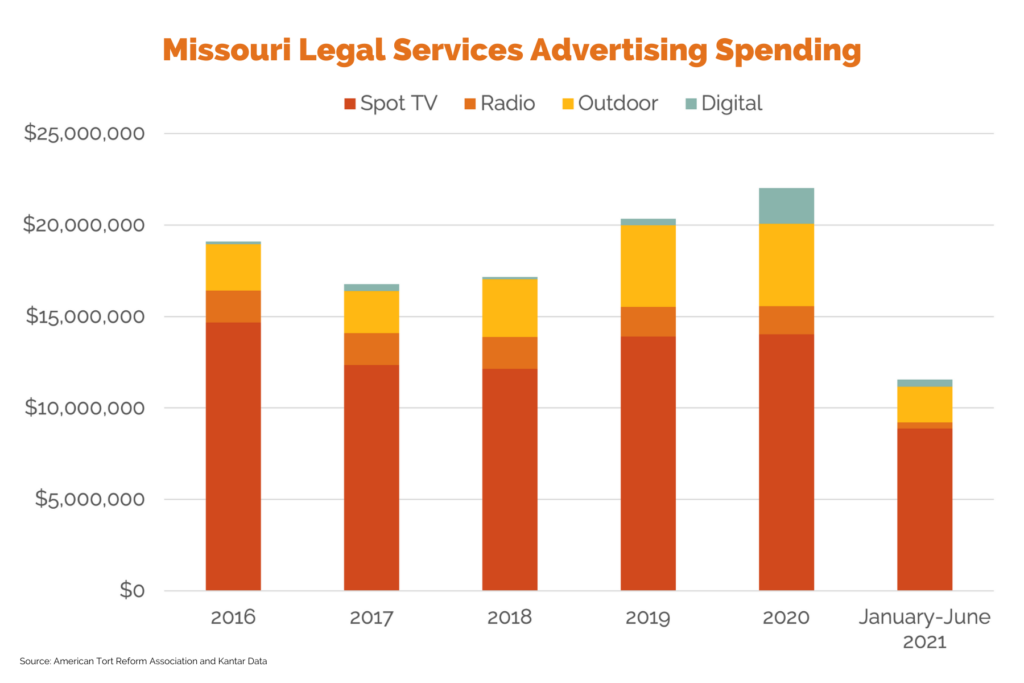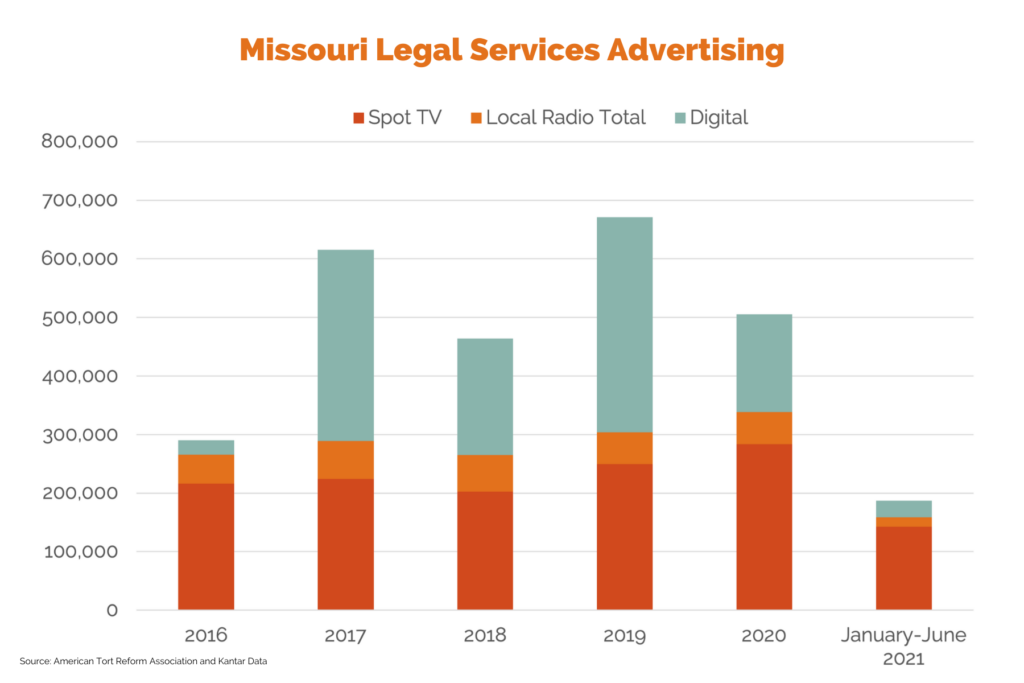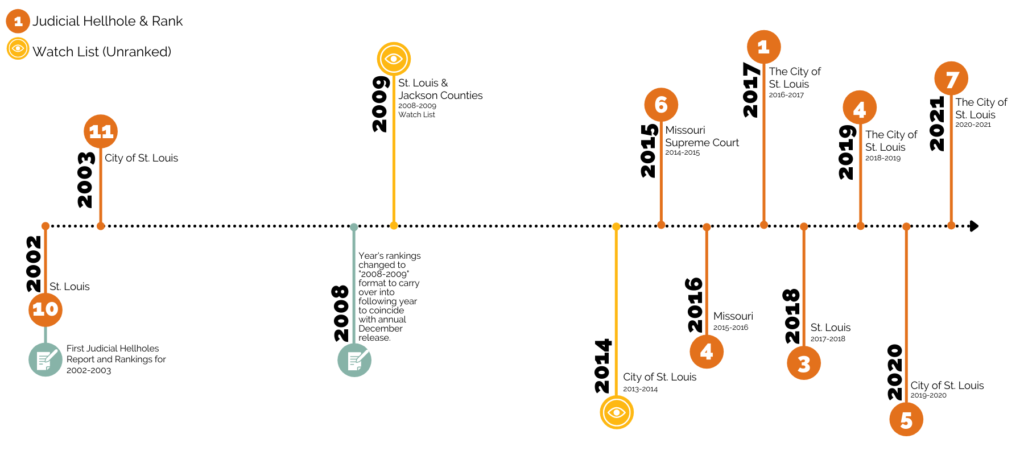Top Recurring Issues
Venue Shopping
Personal injury lawyers flock to St. Louis to file their lawsuits to take advantage of the plaintiff-friendly judges. These “out-of-state” plaintiffs clog the city’s courts, drain court resources, and drive businesses out of the state leading to job loss.
In FY 2018, trial lawyers filed 13,542 civil cases in the City of St. Louis Circuit Court—in a city with an estimated population of 308,626. By comparison, the Circuit Court for St. Louis County had 5,366 cases filed in it that year (about 40% of St. Louis City’s volume) in a county with 996,726 people. St. Charles County only had 1,335 cases filed (10% of the cases filed) in a county that is 33% larger than St. Louis City. In fact, more than half of all civil cases pending in Missouri are in the City of St. Louis Circuit Court.
Junk Science
Despite the legislature enacting expert evidence reform in 2017, St. Louis judges have allowed junk science to be heard in their courtrooms. Plaintiffs’ experts, whose testimony has been determined to not be based in science by other state courts, have been permitted to testify in St. Louis courts.
- 2017: In March 2017, Missouri lawmakers produced, and Gov. Greitens signed, a bill adopting the Daubert standard for the admission of expert evidence in order to stem the flood of “junk science” lawsuits that are scaring job-creating businesses away from the state.
Talc Litigation
Lawsuits alleging a connection between use of Johnson & Johnson’s talcum powder and ovarian cancer in women is certainly nothing new in St. Louis; however, it reached new heights (or lows) in July 2018 when a St. Louis jury awarded $550 million in actual damages and $4.14 billion in punitive damages to a group of 22 plaintiffs. The women claimed that their ovarian cancer was “caused by exposure to asbestos allegedly found in Johnson & Johnson’s baby powder.” Of the 22 women involved in the lawsuit, 17 had no connection to Missouri. Each was awarded the same amount of money, despite there being “different facts for each, and differences in relevant law.”
Roundup Litigation
St. Louis, along with fellow Judicial Hellhole® California, is home to tens of thousands of lawsuits against Bayer AG involving Roundup® weedkiller. St. Louis Roundup trials have been delayed due to the settlement discussions; however, all one has to do is examine the trials in California to understand the plaintiffs’ lawyers’ playbook. The foundation of the litigation is a “junk science” report by the International Agency for Research on Cancer (IARC) that classified glyphosate, the active ingredient in the herbicide Roundup®, as “probably carcinogenic.” IARC is a specialized cancer agency of the World Health Organization, known to be outmoded, heavily politicized, and sub-standard in the quality of its science. The IARC report was the basis for a San Francisco jury to enter a jury award of more than $289 million against Monsanto. IARC’s classification is in stark contrast to more than 800 scientific studies as well as analyses by the U.S. Environmental Protection Agency, Health Canada, and the National Institutes of Health.
In May 2016 Monsanto was hit with a $46.5 million verdict in a case alleging that three plaintiffs developed non-Hodgkin lymphoma by eating foods contaminated with PCBs. The award included $17.5 million in compensatory damages and $29 million in punitive damages. The American Cancer Society recognizes that most forms of non-Hodgkin lymphoma have no known cause, and that lymphomas most often develop as people age. In fact, four earlier trials, three in California and one in St. Louis, resulted in defense verdicts.
Punitive Damages
Missouri courts also have a history of awarding unwarranted and excessive punitive damage awards, which are damages beyond compensation to an injured party that are intended to punish a defendant.
While 2020 legislation sought to reform the system by which punitive damages are awarded, it will still be up to the courts to appropriately apply the new law.
However, a previously enacted limit on punitive damages that was struck down by the Missouri Supreme Court in 2014 was not reenacted, so such excessive punitive damages may persist.
Examples
- Johnson & Johnson v. Ingham (outlined above) yielded $4.4 billion in punitive damages, which was reduced to $1.6 billion.
- In May 2015, a Kansas City jury awarded $251,000 in compensatory damages to a woman who was wrongfully sued by a debt collector for $1,130. This award exceeded by more than 222 times the sum for which she had initially been sued. And on top of that, she also received a wholly irrational punitive damages award of $82.99 million – roughly half of the defendant company’s net income for 2014.
- In Ellison v. O’Reilly Automotive Stores, Inc., (2015) the court upheld a $2 million punitive damages award against an employer in a disability discrimination case brought under the state’s Human Rights Act. While $2 million may not seem extraordinary, the case revolved around a mere demotion, not a firing. And this award for punitive damages was 10 times higher than that for compensatory damages ($200,000), making for a double-digit ratio exceeding the single-digit limit suggested by the U.S. Supreme Court in State Farm v. Campbell and BMW v. Gore.
- In September 2014, the Missouri Supreme Court struck down the state’s statutory limit on punitive damages when applied to common law claims in Lewellen v. Chad Franklin National Auto Sales North. The court ruled that the statute limiting punitive damages to the greater of $500,000 or five times the amount of the total judgment infringed on the right to a jury trial under the Missouri Constitution. The decision is an outlier. Most states limit punitive damages, which punish a defendant rather than compensate a plaintiff for a loss. Some states allow them rarely or not at all. The court allowed punitive damages that were 40 times higher than the plaintiff’s actual damages, ignoring U.S. Supreme Court precedent instructing that punitive damages awarded in excess of a 9:1 ratio very rarely satisfy due process. The Missouri Supreme Court determined that the trial court erred in applying the $500,000 statutory cap, reinstating a $1 million award for punitive damages where the plaintiff’s actual losses totaled just $25,000.
Noneconomic Damages
In July 2012 a divided Missouri Supreme Court struck down the state’s $350,000 limit on noneconomic damages in medical liability lawsuits. In doing so the high court’s activist majority overruled 20 years of precedent that had held limits on noneconomic damages to be “rationally related to the general goal of preserving adequate, affordable healthcare for all Missourians.” Missouri enacted the $350,000 limit on subjective damages for pain and suffering as the average award against medical care providers increased by 52% between 2001 and 2005. Especially for surgeons this represented the continuation of a deteriorating situation as the average payout on claims increased approximately 84% from 1999 to 2005.
Asbestos Litigation
Before the 2017 enactment of the Daubert standard for expert witness testimony, St. Louis had a reputation as a jurisdiction hospitable to asbestos claims. After Daubert was enacted, many plaintiffs’ lawyers moved their asbestos cases from Missouri to Illinois.
- 2016 – St. Louis nudged past Philadelphia (yet another Judicial Hellhole) into fourth place among jurisdictions drawing the most new asbestos lawsuit filings. And St. Louis was second only to Madison County in both new mesothelioma claims and non-mesothelioma lung cancer claims. St. Louis hosted several multimillion-dollar asbestos verdicts in 2016, including a $4.1 million award in January and, in July, an $11.5 million award, $10 million of which were punitive damages.
- 2015 – Plaintiffs’ lawyers specializing in asbestos lawsuits are finding increasingly generous verdicts and helpful judges in St. Louis, just across the Mississippi River from Illinois’ perennial Judicial Hellhole®, Madison County. In Poage v. Crane Co., for example, the plaintiff was awarded $1.5 million in compensatory damages despite having stipulated before trial that such damages were worth only $822,250. Another $10 million was tacked on for punitive damages – that’s six times the compensatory award.
- 2014-2015 – In 2014 and 2015, St. Louis hosted the fifth largest asbestos docket in the country, with about 230 claims filed each year.
- 2010 – Plaintiffs’ lawyers filed just 67 asbestos-related lawsuits in St. Louis in 2010.








